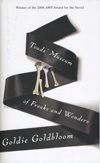Toad’s Museum of Freaks and Wonders
An albino woman, a dwarf named Toad, and two Italian prisoners of war on a rabbit-ridden farm in the nether reaches of Australia: what could be a better premise for a novel? Setting such a bizarre and unique concept at the center of a piece of fiction is a bold strategy, but Goldie Goldbloom’s debut novel, Toad’s Museum of Freaks and Wonders, never falls short of the mark. The winner of the 2008 AWP Award for the novel, it is apparent from the first few pages that you are in the hands of a master; Goldbloom writes with clarity and complexity, balancing abstract questions of identity, love, and value with a tensely developed plot and rich characters.
An albino woman, a dwarf named Toad, and two Italian prisoners of war on a rabbit-ridden farm in the nether reaches of Australia: what could be a better premise for a novel? Setting such a bizarre and unique concept at the center of a piece of fiction is a bold strategy, but Goldie Goldbloom’s debut novel, Toad’s Museum of Freaks and Wonders, never falls short of the mark. The winner of the 2008 AWP Award for the novel, it is apparent from the first few pages that you are in the hands of a master; Goldbloom writes with clarity and complexity, balancing abstract questions of identity, love, and value with a tensely developed plot and rich characters.
Set in Wyalketchem, Australia in 1944, the novel is narrated by Gin Toad, an albino concert pianist who hails from an upper-class family in Perth. She is fallen from this lofty position owing to an evil stepfather and has been married off to the dwarfish farmer, Agrippas Toad. Between them, they have a dusty farm, two living children – Mudsey and Alf – and one dead albino daughter, Joan. Into this scene arrive two Italian prisoners of war, John and Antonio, who are given to the Toads as farm laborers. Soon, however, the line between prisoners and captors is blurred and the novel examines what it means to be a mother, wife, citizen – what it means to belong and to be loved.
Delightful strangeness abounds in this novel, whether it is Mr. Toad’s collection of Victorian corsetry, the foul-mouthed cockatoo that lives on the veranda, or the bright magenta uniforms the Italian POWs are supposed to wear. The characters, too, are not just strange on the surface, but are richly odd, profoundly other. Even the most normal of them, the prisoner Antonio, tells the story of his most formative childhood memory, how as a young boy he was taken by his father from bed one night and brought to a forest where a
man with the axe used it to cleave a chestnut sapling, to split it almost the entire way to its roots, and then the man shoved in a branch to hold the halves apart and laid aside the axe…the men gathered around [Antonio] and carried him to the sapling and now he saw that someone had nailed a picture of the Madonna to the heartwood, as well as a coin showing a man’s organs… they put ash on his head and passed him through the split tree, like thread through the eye of a needle, three times.
This story of what turns out to be a fertility ritual becomes the heart of Antonio’s identity, his promise, his duality, his mystery. Each character tells his or her own story, and each one opens up an entirely new world, bizarre but believable.
Beyond the strangeness, Toad’s Museum of Freaks and Wonders is simply a well-told story with wonderful prose. Place plays a prominent role, and Goldbloom manages to make the distant and foreign Australian Outback understandable, with lyrical description:
the roads themselves have local names, friendlier than the ones given them by government workers….There’s the Pig Slurry Stretch and Metholated Mavis’s Gully and Kickastickalong. Every farm has its kerosene tin wedged between two stumps, or its Coolgardie safe on top of a Model T, and the people here say swing left at the kero tin or turn in at the motor and everyone knows what they mean. Antonio has hung a green milking stool from a stringy-bark at our turn-off. Toad’s stool. Toad’s tool. Toadstool.
The weather, the animals, the isolation, all feed in to the creation of place not just as setting but almost as a character of its own in this novel. Each entity struggles with the question of belonging, the idea of escaping, and the growing realization that imprisonment can be more than just physical. The at turns desolate, at turns fertile landscape of Australia beautifully mirrors the despair and passion of the principal players.
I would not say that Toad’s Museum of Freaks and Wonders is unlike any other novel I have read – for at its heart, it is a love story and a novel that for all its strangeness follows pretty much standard conventions of structure and chronology. However, there is something otherworldly in this book, an otherworldliness that made me look again at this world, which is as rich and promising a gift as a novel can give.





